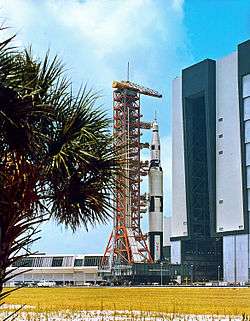SA-500F

SA-500F (alternately SA500F, 500F, or Facilities Integration Vehicle) was a dummy Saturn V used by NASA to test facilities at Launch Complex 39 at the Kennedy Space Center on Merritt Island, Florida during 1966.[1] Tests included the mating of the Saturn's stages in the Vehicle Assembly Building (VAB), the fit of the service platforms, the launcher-transporter operation, the propellant loading system, and the test connections to the mobile launcher and support equipment.[1]
Its three stages duplicated the flight configuration, ordnance, and umbilical connections of their live counterparts. Although inert, the retrograde rockets, ullage rockets, and shaped charges had the dimensions of the live ordnance to let the launch team practice ordnance installation.[2] The first stage only had one real F-1 engine, and the inter-tank section of the first stage had a different paint scheme than flight vehicles. The third stage had a paint scheme matching the Saturn 1B, for which it was originally made. SA-500F was stacked on Mobile Launcher 1 in VAB Bay 1 with the Apollo spacecraft facilities verification vehicle boilerplate.[1]
SA-500F was first stacked in the Vehicle Assembly Building up to the Instrument Unit on March 30, 1966, with the Apollo spacecraft installed May 2.[3]
500F was rolled out to Pad A on May 25, 1966. On June 8, it was rolled back to the VAB temporarily as Hurricane Alma passed, though the ground crew supposed the rollback was more of an exercise than necessity because winds remained below critical for the entire storm.[4] 500F returned to Pad A on June 10.[5] Facility checkout culminated with a "wet test" to verify storage and transfer of propellants.[2]
500F was removed from Pad A on October 14 and destacked on October 21, 1966.[5] The first stage, S-1C-F, was returned to the Marshall Space Flight Center and was eventually scrapped.[6]
The second stage, S-IIC-F, was reassigned as a dynamic test stage at Marshall in early 1967 as S-II-F/D for use in the dynamic test vehicle SA-500D. It is now displayed as part of the Saturn V at the U.S. Space & Rocket Center.[7]
The third stage, S-IV-B-500F, had been manufactured as a dummy third stage for the smaller Saturn IB and used to check Saturn IB launch complex facilities. It was then modified to meet the Saturn V third stage configuration for 500F. In 1970, it was modified into the Skylab Workshop Dynamic Test Stage and was shipped in December to the Johnson Space Center for dynamic testing. In June 1971, it was shipped to Marshall for Skylab workshop static testing; and in June 1974 it was returned to KSC.[8] Its fate is not known.
See also
- SA-500D, the Saturn V Dynamic Test Vehicle
References
- 1 2 3 "Saturn Vehicle History". Space Launch Report. December 22, 2010. Retrieved February 12, 2011.
- 1 2 Benson, Charles D.; Faherty, William Barnaby (1978). Moonport: A History of Apollo Launch Facilities and Operations. Scientific and Technical Information Office, NASA. Archived from the original on 2004-11-17.
- ↑ von Braun, Wernher (2010). Buckbee, Ed, ed. The Rocket Man: Wernher von Braun: The Man Who Took America to the Moon: His Weekly Notes: 1961-1969 (DVD). Steward & Wise Music Publishing. p. 17. ISBN 978-1-935001-27-0. (NOTES 4/4/66 RUDOLPH)
- ↑ Lawrie, Alan; Pearlman, Robert (January 7, 2008). "Untold Apollo: How tennis shoes and tug-of-war toppled the mighty Saturn V". CollectSPACE. Retrieved February 12, 2011.
- 1 2 Teitel, Amy Shira (October 27, 2014). "Rocking a Rocket: The Saturn 500F Shake Test". Vintage Space. Retrieved December 19, 2014 – via Popular Science.
- ↑ "Saturn V 500F question". NASASpaceFlight.com. January 25, 2007. Retrieved February 12, 2011.
- ↑ Kyle, Ed (January 21, 2007). "Saturn V 500F question". NASASpaceFlight.com. Retrieved February 12, 2011.
- ↑ Memorandum from Larry Mauk, Kennedy Space Center, to Mike Wright, "Saturn V numbers," February 20, 1992, with attachment entitled, "Stage S-IVB-500F History".